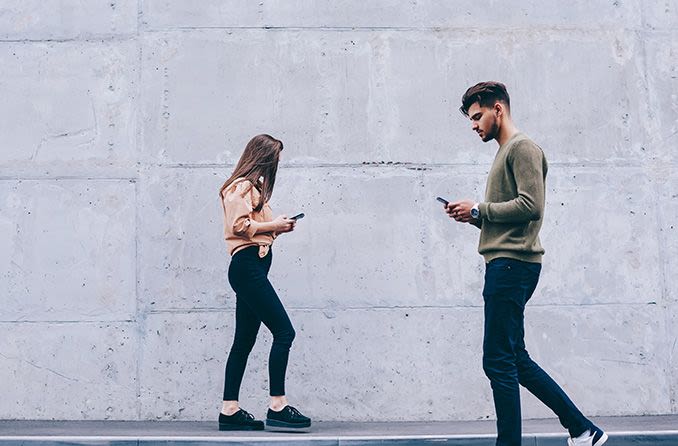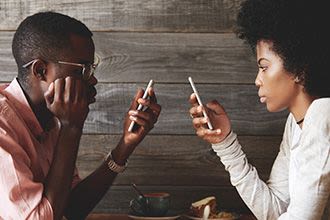Is social media making eye contact a rarity?

Is social media making it harder for us to make eye contact?
Absolutely. We’re all spending more time staring at our screens (leading to digital eye strain and an increase in myopia) and less time looking each other in the eye.
Whether we’re posting photos to Instagram, creating a TikTok video, snapping a reply or liking a friend’s Facebook photo -- we’ve got our eyes on our devices and not on each other.
What can we do? Pause the chatter, give your thumbs a rest and talk to a loved one, neighbor, friend or even a stranger instead.
Yes, social media is making it harder to make eye contact, but that just means we have to work harder to talk face to face.
But just how important is eye contact to a conversation, why do we avoid eye contact and how do you communicate with eye contact? Let’s answer these frequently asked questions about eye contact one by one.
Why is eye contact important in a conversation?
Connection and happiness are inextricably woven together, and a study titled “What makes eye contact special” found that eye contact is a crucial component to both.
Eye contact is the mode of body language considered to be the strongest form of nonverbal communication. but social media removes not only the perceived need for eye contact, but the capability to participate in it altogether.
People form connections, develop empathy, gain understanding and, in some cases, even fall in love through eye contact. Maintaining eye contact with another person provides an unconscious communication stream and enables us to transfer information about our emotions and mental state nonverbally.
Eye contact, or lack thereof, can mean different things -- including respect, interest or appreciation -- to different people. We are also able to understand more about a person via simple cues, such as the narrowing or widening of their eyes or noticing their eyes dart about.
It’s for these reasons that eye contact is so vital. These instinctive observations and connections help us develop relationships, gain the trust of colleagues and influence decisions.
Why do we avoid eye contact?
Despite its importance and all the many benefits, the ability in our digital world to make and sustain eye contact is increasingly waning.
The average American mobile user checks his or her phone 52 times a day, a 2018 study found. We are constantly glancing at our phones and checking (and rechecking) all our various social media accounts.

Civility, as well as eye contact, may be waning because of our focus on social media. A 2018 Psychology Today article asks the question “Is social media making us ruder?” and then answers it by citing research that a "lack of eye contact" may be to blame.
What does all of this mean?
Well, that quick glance at Instagram, an email or a YouTube video while at the same time engaged in conversation with someone close to us (or even in line at the checkout counter) has almost become acceptable. Focusing on the phone instead of the person depreciates our perceived value of (perhaps even our ability to make) eye contact.
SEE RELATED: Is too much screen time bad for kids?
How do you communicate with eye contact?
Is there a right way or a wrong way to make eye contact? If we’re not making eye contact as much as in the past, how much is the right amount?
Michigan State University researchers recommend adhering to a 50/70 rule when making eye contact while engaged in conversation. Maintain eye contact for 50% of the time while speaking and 70% of the time while listening to someone.
And the researchers even outlined some rules for seeing eye to eye:
Always try to establish eye contact before speaking, then hold it for four to five seconds at a time, three to four seconds in a group setting.
To really make your eye contact count, also use your eyes to help convey interest. Try subtly mimicking subtle aspects of the other person’s body language, facing them and sitting in a similar posture.
However, don’t stare. Studies show that holding eye contact for longer than 10 seconds can make the other person feel uncomfortable, which should be the opposite of the intended response.
On the other hand, looking down constantly while making eye contact can indicate insecurity or nervousness. When you look away, glance toward the sky, communicating confidence and instilling trust.
How to increase eye contact and decrease social media
How can you make more eye contact with people again? That starts with reducing your obsession with social media.
Four ways to regain control of your life by checking your phone less through the day:
SET LIMITS: Create time limits in Facebook and Instagram apps in your phone’s settings.
STOP ALERTS: Disable notifications of social media posts.
GIVE IT A REST: Create a no-phone zone at dinner time and in the bedroom
CALL IT QUITS: Go cold turkey – delete your apps!
Consider this a homework assignment: Social media definitely is making it harder to make eye contact, so tune out social media for a few minutes and tune in to the person across from you. Look each other in the eye and talk, listen and laugh.
READ NEXT: Can eye movements indicate lying?
Page published on Saturday, January 18, 2020






